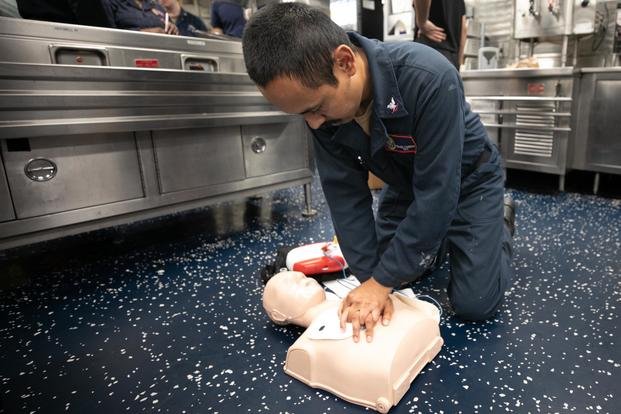Over the weekend, I recertified as a Red Cross lifeguard and updated my cardiopulmonary resuscitation (CPR) certification. Since I'm a trainer and swim coach, these professional certifications need to be up to date, but the refresher courses are recommended for anyone as the standards change every few years.
In fact, since 2000, international guidelines on CPR have changed three times, the latest in 2015. These changes may make performing CPR on someone more appealing, especially if mouth-to-mouth rescue breathing is a showstopper for helping a stranger in need.
No Mouth to Mouth Needed (in Many Cases)
In most heart-attack cases, just giving chest compressions (no breaths) can be lifesaving. The main reason for people not helping a victim when CPR is needed is, they don't want mouth-to-mouth contact.
Mouth-to-mouth resuscitation has a potential to spread disease, victim vomit and fentanyl-laced overdoses to the rescuer. This can make the most qualified person a bit uncomfortable with giving aid.
However, studies show that rescue breaths often interrupt the blood-pumping compressions that keep a person alive. Study (CPR Without Mouth to Mouth) -- Heart Attack Victims.
If mouth to mouth (rescue breathing) is needed for a choking or drowning victim whose oxygen has been deprived, it is now recommended to use a resuscitation mask. You can order an adult mask and infant mask on Amazon for less than $10 and keep one in your car, backpack or home.
The tempo for adult rescue breaths is one breath every 5-6 seconds and three seconds for a child 5 years old and younger. You should take the training course before making these purchases, so you know how to use them effectively.
Compressions: Breath Ratio and Learning to Use the AED
Over the past decade, the change to compressions-to-breaths ratio is 30 chest compressions (2-2.4 inches deep) and two breaths (30:2) on an adult who does not have a pulse. The ratios change when you have a second CPR-trained person helping to split the roles of compression and breaths. However, if you are concerned about giving mouth to mouth, just do the compressions until Emergency Medical Services (EMS) personnel arrive. Make sure you communicate with others who can make the call to 911.
Another skill you should learn (or relearn if it's been awhile since your last CPR class) is how to use the automated external defibrillator (AED) that you can now find just about anywhere these days as part of a business's emergency medical kit.
An AED is a medical device that can analyze the heart's rhythm and, if needed, deliver an electrical shock (defibrillation) to help the heart reestablish an effective rhythm. CPR courses teach how to use the AED while you wait for EMS to arrive.
Important note: The AED does not replace CPR, but it can help you establish a normal heart rate when a victim is in ventricular fibrillation (V-fib). CPR helps to maintain blood flow to the brain and organs to keep victims alive, while the AED checks and corrects heart rhythm.
Both AED and CPR are important and increase the odds that a person survives a heart attack. Taking training for these techniques together is going to help you save the life of a heart-attack victim by providing timely assistance with confidence.
Advice for Young People Who Are Preparing for Adulthood and Service
It was good to see that the majority of the certification class was young people who were getting training to become lifeguards for summer jobs. If you want to start the process of becoming an asset in life-or-death situations, these are the basic skills you can start learning at a young age.
If you are considering joining the military, police or becoming a firefighter or EMS, these skills will be foundational to your growth and mindset as you move forward in life. Once you learn to become an asset, you will work harder to maintain these skills. This will help you take your personal physical training, tactical skills and emergency training to new levels.
Seriously, everyone should consider getting qualified in any of these programs and being able to save a life. Check out the sources below for information on how you can become an asset.
American Heart Association CPR
Want to Learn More About Military Life?
Whether you're thinking of joining the military, looking for fitness and basic training tips, or keeping up with military life and benefits, Military.com has you covered. Subscribe to Military.com to have military news, updates and resources delivered directly to your inbox.


















